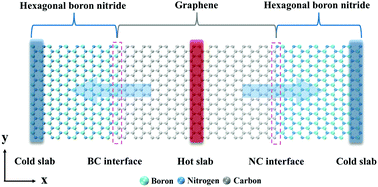Effect of strain and defects on the thermal conductance of the graphene/hexagonal boron nitride interface
Abstract
In-plane heterojunctions, obtained by seamlessly joining two or more nanoribbon edges of isolated two-dimensional atomic crystals such as graphene and hexagonal boron nitride, are emerging as nanomaterials for the development of future multifunctional devices. The thermal transport behavior at the interface of these heterojunctions plays a pivotal role in determining their functional performance. Using molecular dynamics simulations, the interfacial thermal conductance of graphene/hexagonal boron nitride (GE/BN) in-plane heterojunctions was investigated. The GE/BN heterostructure has a remarkably high interfacial thermal conductance, and thermal rectification occurs at the interface. The results also show that the interfacial thermal conductance is effectively modulated by strain and defect engineering. The atomic defect location can affect the phonon transmission at the interface. Interestingly, compared with the nitrogen doping effect, the boron doping defect can more effectively facilitate vibrational coupling at the interface in the graphene sheet. Stress distribution and vibrational spectral analyses are performed to elucidate the thermal transport mechanism. The results of this study may provide a foundation for future research attempting to manipulate the interfacial thermal conductance in other two-dimensional heterostructures.



 Please wait while we load your content...
Please wait while we load your content...